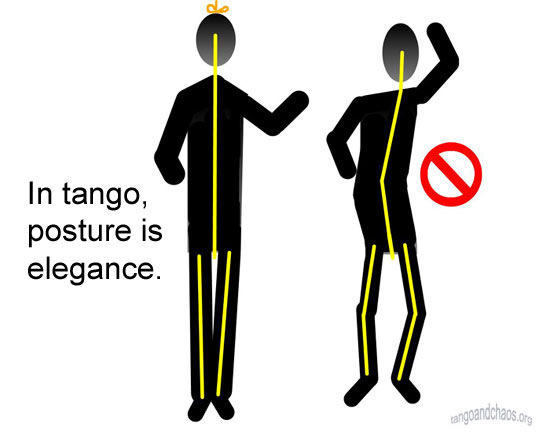String Theory

Poor posture is tiring, it looks bad, and it inhibits your dancing. Your head weighs
about the same as a light bowling ball. Holding it forward stresses your back.
Many tango troubles begin with poor posture. Poor posture creates a cascading set of problems that affect both balance and embrace. It throws you off, it throws your partner off, and it creates muscle tension that will cramp your dancing in ways you can't even feel. And if you’re interested in elegance and style, posture is most of it. In fact, good posture combined with a good step is all of it. (Just before he died, Petroleo once said he thought Miguel Angel Zotto was the best dancer in the world because of his posture.)
Finally, bad posture is tiring. It's an inefficient way to use your body, and when you dance 5 or 10 hours a week, bad posture can wear you out. Play whatever mental games you need to maintain good posture. Be a relaxed puppet, pulled up by a string... or think about being the tallest, most relaxed person on the floor. There are a lot of distractions in a crowded milonga. Other dancers can move in close or even bump you; an inexperienced partner can pull you off center; and sometimes you just get lost in the music and start slumping... so use a little discipline. Use a checklist and tell yourself, "be tall", or "string... relax" or "chest up". Good tango takes concentration and discipline. It takes a long time to develop good habits—and even longer to get rid of bad ones. If you lose your posture, you're screwed. So do whatever it takes.

Think of an imaginary string pulling you up as you dance. It straightens your
knees, neck and vertebrae, and it keeps your head centered and balanced.
Dancing tall will also center you from the front. Do your string exercise facing a mirror, and check to see if everything is symmetrical. Other than your arms, your left and right side should be a mirror image of each other. Your head, shoulders and hips should be at the same level, and your legs need to be fully extended and relaxed. Heels are comfortably close, with the toes turned slightly out for balance. As the string centers you, your shoulders drop and relax. Then, add just enough muscle tension to raise your arms for the embrace.

Use the string exercise in front of a mirror to look for symmetry.
The goal is to center ourselves, and move efficiently. We want to eliminate inefficient movement, so that we don’t waste energy using unnecessary muscles. Using unneeded muscles creates tension that works against us. By relaxing the muscles we don’t need, the ones we do need won’t have to overcome them. We also burn less “mental energy”—that is, by eliminating unnecessary movement and muscle tension, our brain has less to think about. We want to keep our neuromuscular-pathways from becoming overloaded. In the picture above, String Man is standing efficiently and using as few muscles as possible, so the communication system that connects them is doing less work.
For me, tango presents a couple of problems. One is the shoulders. It can be difficult at times to keep the shoulders down, back, and relaxed, while dancing in through the minefield of a crowded milonga with your arms held up in the embrace. One of the keys is concentration ("relax... shoulders down"), and the other is good technique. When a man leads well with the chest and torso, and the woman can follow without needing signals from his arms, and both can dance with relaxed shoulders. The other problem is the head. We'll talk about that later.